A modified subconjunctival enucleation technique in dogs and cats
Globe removal is indicated in patients with blind, painful eyes or patients with nonresectable intraocular tumors.
An enucleation is the most common orbital surgical procedure performed by veterinary ophthalmologists and general practitioners.1 In veterinary medicine, enucleation is defined as the removal of the globe, nictitating membrane, eyelids, and, depending on the technique, conjunctiva. Globe removal is indicated in patients with blind, painful eyes or patients with nonresectable intraocular tumors.1
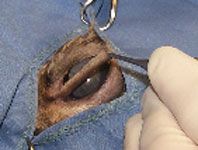
1. A lateral canthotomy is performed, and the upper eyelid margin is excised 5 mm posterior to the mucocutaneous junction in a single continuous fashion.
The three most commonly described enucleation techniques are the subconjunctival, lateral, and transpalpebral approaches. The main objectives of the subconjunctival technique are to remove the globe, nictitating membrane, and eyelid margins, in that order, while preserving as much soft tissue as possible to minimize subsequent orbital depression.2,3 The lateral approach removes the tissues in a similar order but first involves partially excising the eyelids for better surgical exposure.4 The transpalpebral technique is often used in patients with associated ocular surface infection or neoplasia. This method involves suturing the palpebral fissure closed and removing the globe, nictitating membrane, and conjunctiva as one encased unit to prevent contact between the remaining ocular surface and orbital contents.5
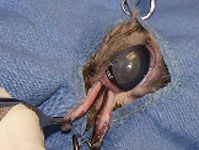
2. The lower eyelid margin is excised in a similar manner as shown in Figure 1.
In this article, we describe a modification to the subconjunctival enucleation technique that provides improved exposure of the globe, extraocular muscles, optic nerve, and vascular structures of the orbit.
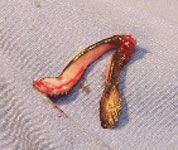
3. The excised eyelid margins.
TECHNIQUE
After premedication, induce general anesthesia, and aseptically prepare the periorbital skin and eyelids for the procedure by clipping the periorbital area and irrigating the periorbital tissues and globe with 5% povidone-iodine ophthalmic solution. For better pain control, consider administering retrobulbar injections6 (0.5 to 1 ml) of a combination of lidocaine hydrochloride 2% and bupivacaine 7.5% with or without epinephrine 1:1,000.

4. The nictitating membrane is excised at its base with Mayo scissors.
Perform a lateral canthotomy, and excise the eyelid margins 5 mm posterior to the mucocutaneous junction in a single continuous fashion (Figures 1-3) with Mayo scissors. Then grasp the nictitating membrane with tissue forceps (e.g. Bishop Harmon), and excise it at its base with Mayo scissors (Figures 4 & 5). Next, incise the bulbar conjunctiva 3 to 5 mm posterior to the limbus, and transect the extraocular muscles near their scleral attachments (Figure 6). Sever the retractor bulbi muscle fibers and optic nerve (Figure 7) with curved enucleation scissors, and excise the remaining conjunctiva. Before excising the globe, a ligature may be placed around the optic nerve and the associated short and long posterior ciliary vessels before they enter the sclera. We do not perform this step; it is a matter of surgical preference.
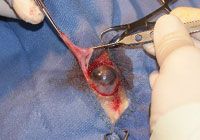
5. The nictitating membrane including the gland of the third eyelid before the final cut at the medial canthus.
To improve the cosmetic appearance postoperatively, place an orbital meshwork of nonabsorbable monofilament suture (such as 4-0 nylon), anchored to the orbital rim periosteum, in a continuous pattern (Figure 8). Close the conjunctiva and subcutaneous tissues with 5-0 absorbable polyglactin 910 in a simple continuous pattern. Appose the skin with 4-0 nonabsorbable monofilament nylon or polypropylene in a simple interrupted or cruciate pattern (Figure 9).
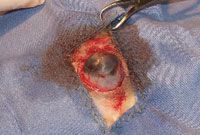
6. The remaining bulbar conjunctiva has been incised 3 to 5 mm posterior to the limbus, and the extraocular muscles transected near their scleral attachments.
Patients may be discharged the same day and should be given appropriate postoperative antibiotic, anti-inflammatory, and analgesic medications. In addition, Elizabethan collars are recommended until suture removal to prevent self-trauma.
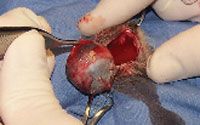
7. The retractor muscle fibers and optic nerve have been severed, and the globe can be removed after the remaining conjunctiva is excised.
DISCUSSION
This article describes a modification to the routine subconjunctival enucleation technique3 that involves removing the eyelids and nictitating membrane before excising the globe. This method offers good visibility and better access to the globe and extraocular muscles. After eyelid margin and nictitating membrane removal, the globe is easily visualized and manipulated. Extraocular muscles can be easily followed to their attachments, and the globe can be positioned to see the optic nerve before transection. Some authors advocate clamping the optic nerve with hemostats or ligating the associated vasculature before optic nerve transection7,8 ; however, omitting these procedures has not had a negative impact on the surgical outcome in previous studies or in the case series described here (see boxed text).9 Easier access to the optic nerve is particularly important in cats because their tight palpebral fissures and short optic nerves make enucleation more challenging. The optic chiasm can be damaged if excessive traction is placed on the globe, resulting in possible blindness in the contralateral eye after enucleation.7,10
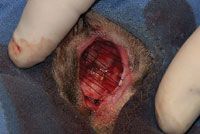
8. An orbital meshwork of nylon suture has been anchored to the periosteum.
The modified subconjunctival enucleation technique offers an alternative approach for globe removal in dogs and cats. This technique is not indicated in patients with corneal ulcers or ocular infections. In such cases, a transpalpebral technique is more appropriate.

9. The conjunctiva and subcutaneous tissues are closed in a continuous pattern, and the skin is apposed in either a simple interrupted or cruciate (shown here) pattern.
In our case series, this method was not associated with any adverse complications, and we think it may be particularly useful in general practice, where enucleation may not be a routine procedure. Long-term follow-up was not obtained in our case series. Keep in mind that a potential adverse effect related to enucleation using this or any technique is mucocele formation.

A modified subconjunctival enucleation technique: A case series
Robert L. Swinger, DVM
Karl A. Schmidt, Jr., DVM, DACVO
Animal Eye Specialty Clinic
20290 N.W. 2nd Ave.
Miami, FL 33169
Susan M. Carastro, DVM, MS, DACVO
Animal Eye Specialty Clinic
372 S. Powerline Road
Deerfield Beach, FL 33442
REFERENCES
1. Spiess BM. Diseases and surgery of the canine orbit. In: Gelatt KN, ed. Veterinary ophthalmology. 4th ed. Ames, Iowa: Blackwell Publishing, 2007;539-558.
2. Slatter D, Wolf ED. Orbit. In: Slatter D, ed. Textbook of small animal surgery. Philadelphia, Pa: WB Saunders, 1993;1245-1263.
3. Kuhns E. Enucleation of the eye by subconjunctival ablation. Vet Med Small Anim Clin 1976;71:1433-1440.
4. Bellhorn R. Enucleation technique: a lateral approach. J Am Anim Hosp Assoc 1979;8:59-60.
5. Wolf ED. Enucleation of the globe. In: Bojrab M, ed. Current techniques in small animal surgery. Philadelphia, Pa: Lea & Febiger, 1990;119-123.
6. Accola PJ, Bentley E, Smith LJ, et al. Development of a retrobulbar injection technique for ocular surgery and analgesia in dogs. J Am Vet Med Assoc 2006;229(2):220-225.
7. Slatter D. Orbit. In: Slatter D, ed. Fundamentals of veterinary ophthalmology. 3rd ed. Philadelphia, Pa: Saunders, 2001;496-530.
8. Ramsey DT, Fox DB. Surgery of the orbit. Vet Clin North Am Small Anim Pract 1997;27(15):1215-1264.
9. Allgoewer I, Noller C, Reese S. Enucleation: Is ligation necessary? in Proceedings. Am Coll Vet Ophthalmol, 2006;45.
10. Stiles J, Buyukmihci N, Hacker DV, et al. Blindness from damage to the optic chiasm (letter to editor). J Am Vet Med Assoc 1993;202(8):1192.